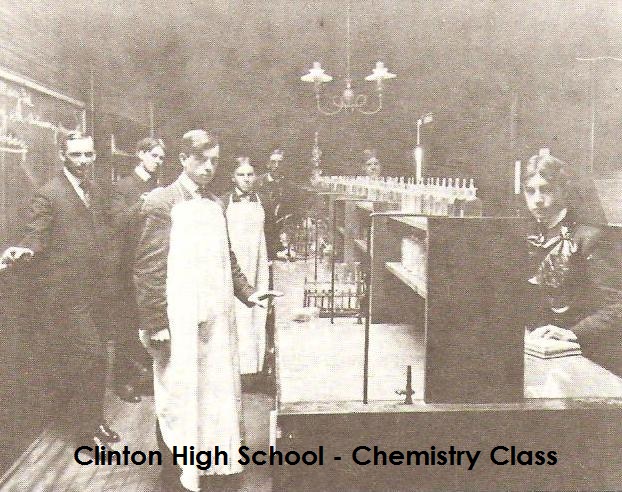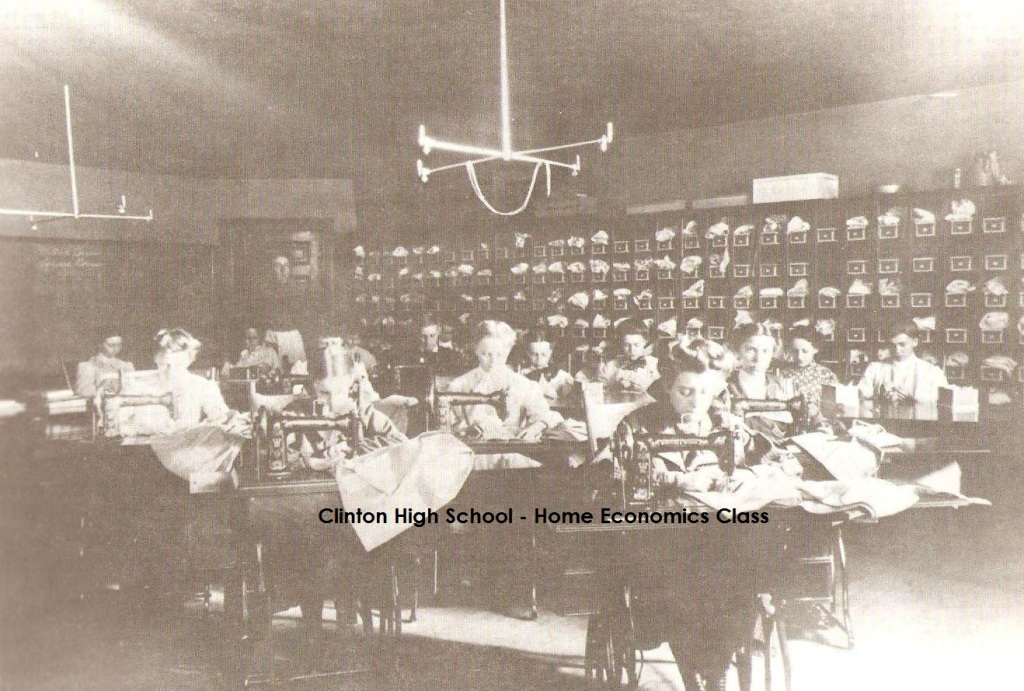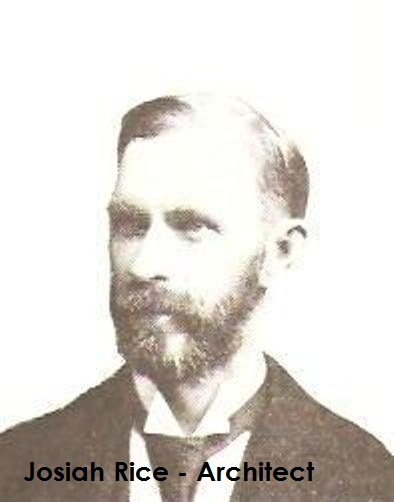New Clinton High School 1888-1889
From: The Clinton Daily Herald; Wednesday Evening, July 25, 1888, P. 3
Transcribed by a Clinton County IaGenWeb volunteer.
NEW HIGH SCHOOL BUILDING.
An Imposing Structure – The Contract Let to a Master Builder – Home Material
Used – Etc.
 At the meeting of the School Board of the Independent district of Clinton,
Monday evening, the contract was let to the lowest bidder – Mr. J. W. Smith, of
Clinton – to construct a fine High School building on the site of the old St.
Mary’s church, now about removed.
At the meeting of the School Board of the Independent district of Clinton,
Monday evening, the contract was let to the lowest bidder – Mr. J. W. Smith, of
Clinton – to construct a fine High School building on the site of the old St.
Mary’s church, now about removed.
Mr. Smith’s bid - $31,358.81 - brings him the contract by but $38.19 instead of
its going to a foreign contractor; and Ben Bollman & Co. get the contract for
plumbing by but $63, which is the best evidence Clinton taxpayers want that the
bids were down as near the bottom notch as good work could be done. The
tax-payers are also congratulating themselves that good mechanics and
responsible men have secured the work. That this is so the work done by them in
the past gives evidence, for Mr. Smith can point with pride to Mr. P. S. Towle’s
new house, which he built, and Judge Thayer’s house, which he is now at work on,
besides many smaller structures, while Messrs. Bollman & Co. have done plenty of
work about the city to which they can point with confidence. These honest words
could have been said also of the other home bidders, if they had secured.
THE CONTRACT.
The School Board at the last session instructed its president and secretary to
sign a contract with Mr. Smith, he to give bonds for the faithful performance of
the work in the sum of 25 percent of the whole amount of the contract, also to
keep the building fully insured as work progresses against storm and fire. Mr.
Smith’s bondsmen, it is rumored will be some of the most substantial business
men of the city.
THE BUILDING.
 The structure will be a handsome one, the plans of which were drafted by
Architect J. L. Rice, one of the most competent and reliable in the Northwest,
whose rooms are in the second story of Curtis Bros. & Co.’s office building. Mr.
Rice seems to have had happy thoughts when drafting the plans, for he has
provided an imposing monument to public education indeed. The building will have
two fronts, one on Sixth avenue, looking north, and one on Fourth street,
looking on De Witt park. It will be two stories high with basement and attic. On
the corner will be a tower, of generous proportions, which will be 90 feet from
base to top. The area covered by the building will be 83x93 feet. Its foundation
will rest on solid rock, excavation to the depth of but four feet being
necessary to reach the limestone formation on which that part of the city
stands.
The structure will be a handsome one, the plans of which were drafted by
Architect J. L. Rice, one of the most competent and reliable in the Northwest,
whose rooms are in the second story of Curtis Bros. & Co.’s office building. Mr.
Rice seems to have had happy thoughts when drafting the plans, for he has
provided an imposing monument to public education indeed. The building will have
two fronts, one on Sixth avenue, looking north, and one on Fourth street,
looking on De Witt park. It will be two stories high with basement and attic. On
the corner will be a tower, of generous proportions, which will be 90 feet from
base to top. The area covered by the building will be 83x93 feet. Its foundation
will rest on solid rock, excavation to the depth of but four feet being
necessary to reach the limestone formation on which that part of the city
stands.
The first floor is admirably planned and will be divided into public library
room, superintendent’s office, reception room, two school rooms, corridors, etc.
The second floor will be exclusively for high school purposes. It will contain a
general assembly room, and recitation rooms.
The basement will be partitioned off for a chemical laboratory, toilet rooms,
heating apparatus departments, etc. The attic will be used for storage, etc. The
whole interior will be finished in oiled yellow pine and oak.
The exterior will be of red brick trimmed with Ohio sandstone and galvanized
iron, covered with a slate roof. The windows will be of cathedral and plate
glass.
The awarding of the contract to Mr. Smith will cause the spending of all the
money excepting that paid for the sandstone trimming and slate roof at home.
THE MATERIAL.
The brick, some 600,000 or 700,000, will be bought of Thos. Price; the lumber
will be furnished by C. Lamb & Sons; the trimmings by Curtis Bros. & Co.; and
the galvanized iron and slate for roof by Geo. W. Parker, of Lyons. The labor,
even to the stone cutting, we are informed, will be performed by Clinton
mechanics, so there is indeed cause for congratulation – not alone because a
needed building which will be an ornament to the city will be built, but because
the laboring classes will have the benefit of several thousand dollars thus kept
in circulation in the city.
Work is to commence on the structure as soon as possible, probably within a
week, and the building is to be ready for occupancy in a year.
TOWN CLOCK.
At this time the thought occurs to the Herald that in the tower to be
constructed will be a fine place to put a city clock. Its location in the city,
its altitude and the fact that it is a public building and Clinton has not a
town clock, makes the thought worthy of consideration.
The Clinton Daily Herald; Saturday Evening, August 31, 1889, P. 3
A MAGNIFICENT EDIFICE.
Clinton’s New $35,000 High School and Library Building – The Finest School House
in the State.
On Monday the public schools of the Independent School District of Clinton will
be opened for the fall term, and on that day the new High School and Library
building will be occupied for the first time.
 It is indeed a magnificent structure, and one of which our people have reason to
be extremely proud. It is a conceded fact that a finer school building than this
cannot be found in the State of Iowa.
It is indeed a magnificent structure, and one of which our people have reason to
be extremely proud. It is a conceded fact that a finer school building than this
cannot be found in the State of Iowa.
The building is located on the corner of Sixth avenue and Fourth street,
opposite De Witt Park. It has a frontage of eighty-three feet on Fourth street,
and ninety-three on Sixth avenue. It is built of red brick, with stone trimmings
and slate roof. It is two stories in height besides the basement and attic, and
the summit of the tower, located at the northeast corner of the building, is
ninety feet from the ground.
There are two large entrances to the building – the main entrance on Fourth
street, and a side entrance on Sixth avenue, each being composed of large double
doors, and set with handsome plate glass panels.
Above the main entrance on Fourth street is a plate of buff colored terra cotta
bearing the words:
“HIGH SCHOOL AND LIBRARY.”
Passing through the large doors you find yourself in a vestibule, with a pair of
large glass doors in front. On the right hand is a small door leading to the
Superintendent’s office, and on the left is another door which leads to the
library.
Turning to the right you pass through the small door and ascend a few steps and
you are in the Superintendent’s reception room, an apartment of about 12x15 feet
in size. His private office is connected with this room on the north by large
sliding doors, and is pleasantly located in the northeast corner of the
building. It is fitted with a fire-place, book cases, table, desk, etc.
A door on the west side of the reception room opens into an apartment, 15x31 ½
feet, which will be fitted up as a museum. Mr. Henry F. Bowers has generously
donated his splendid collection of curiosities and antiquities to the High
School with the understanding that the specimens shall be properly classified
and displayed. This collection will, of course, be added to all the time, and
will prove a source of pleasure and study for all.
Passing out of the Museum and crossing the large corridor, which you would have
reached had you passed through the large glass doors from the vestibule, you
enter the library. This is a large room 29x36, occupying the south-east corner
of the edifice. The room is fitted with a large number of book cases, which will
be well filled when the books are all placed in their proper positions. A wash
room is connected with the library at the south-west corner of the apartment.
The west half of the first floor is occupied by two school rooms, each being
29x33 feet in size, and generously supplied with cloak-rooms and closets.
The ceiling in all of the rooms on the first floor is 13:6 clear.
In the center of the building on the south side, is a stairway leading down to
the girls’ toilet rooms and a large flight of winding stairs leading to the
second floor.
The second floor is devoted exclusively to the High School, and is divided into
four rooms – the assembly room, recitation rooms for German, mathematics, and
science, and an apparatus room, in which are kept the apparatus for giving tests
and illustrations in science and philosophy.
A small vestibule is located at the top of the grand stairway, in front of which
are the large glass doors leading into the assembly room – a spacious apartment,
48x53 ½ feet in size, the ceiling of which is 18 feet clear.
In this room all members of the High School will assemble when not reciting in
the recitation rooms, and will seat 140 pupils. The room is lighted from the
north and east by nine large double windows. A bookcase contains a large number
of reference books, and a large slate blackboard extends around the south and
west sides of the room.
The principal’s platform and desk is situated in the center on the south side,
behind which are placed electric call bells connected with the other rooms, and
a speaking tube running into the Superintendent’s office and another to the
engine room.
A door in the north-west corner of the assembly room leads to the mathematics
recitation room, which is 29x33 feet with 13 ½ foot ceiling.
 The German recitation room is located in the southeast corner, being 23x29 feet.
The ceiling of this room is the same height as all the others on the second
floor, except the assembly room – 13 ½ feet – the latter being 18 feet.
The German recitation room is located in the southeast corner, being 23x29 feet.
The ceiling of this room is the same height as all the others on the second
floor, except the assembly room – 13 ½ feet – the latter being 18 feet.
Across the hall, west from the German recitation room, is the science recitation
room in size, 26x29. In the rear of the teacher’s platform, which is located on
the north side, are a pair of large sliding doors which open into the apparatus
room. The doors are kept closed until time for tests or illustrations to be
given, when they are thrown open and everything is right there in readiness. A
door leads from the apparatus room into the recitation room for mathematics,
another opens into the corridor, and a flight of stairs descends to the first
floor.
All of the woodwork of the first and second floors is of hard pine, finished in
its natural color, and varnished the same as furniture. The ceilings are also
ceiled with the same material and finished in the same manner, all of which,
together with the large, handsome windows, presents a rich and handsome
appearance.
It is probably that the two school rooms on the first floor will not be used
this term.
Descending the stairs at the Sixth avenue entrance you find yourself in the
basement. To your right as you enter is the chemical laboratory, and on the left
is the boys’ toilet room.
In the basement is also located the engine and boiler rooms by which the
ventilation of the building is operated. These are in charge of Mr. Charles J.
Cole, a careful and experienced engineer, and a polite and accommodating young
gentleman, who is found willing to explain the workings of the machines.
The steam is generated in a twelve foot boiler, 40 inch shell, containing thirty
3 ¼ inch flues.
A ten horse power upright engine, 6x8 inches in dimensions, operates a B. F.
Srurtevant hot air fan, 100 inches in diameter and 28 inches wide.
The heat the building the fresh air is drawn by the fan through a large cold air
duct into an air tight room, this preventing the possibility of its being mixed
with foul air. It is then drawn through five coils of 1 inch pipe, each coil
representing 250 feet of pipe. These coils are heated by steam, and as the air
passes among them it becomes heated to a certain temperature and is then forced
by the fan through conveyor pipes to each room in the building. The hot air will
heat the coldest room to a temperature of 70 degrees when it is 30 degrees below
zero on the outside. In excessively hot weather a fire can be kindled under a
small upright boiler which is there for that purpose, and the fan will send cool
air through the building.
The furnace is built for coal, the rate being 3 feet and 5 inches long. It takes
only 25 pounds of steam to supply the engine – which makes 270 revolutions a
minute – and the coils for heating the air. One coil is supplied by the exhaust
pipe of the engine, while the other four are fed directly from the boiler. The
furnace will consume only one-half ton of coal a day.
A large cistern in the south-east corner of the basement, fed by the drain pipes
from the roof, holds water enough to supply the boiler the entire winter. After
being used in the boiler the steam is conducted into a trap and there condensed
into water again and thus is used over and over again. It is estimated that
about three barrels of water a day is the amount actually used.
There is a Dean pump to force the water into the boiler.
The engine will be run during the school hours, when necessary, and will then be
shut down until the next morning.
Mr. Cole, besides having charge of the engine, will act as janitor of the entire
building.
A large fuel room adjoining the engine room, holds about 70 tons of coal, the
winter supply of which is now being received.
The building has the best possible plan for ventilation, is supplied with gas
connections for lighting, electric signal bells, plenty of water, and all the
modern conveniences.
Mr. Josiah L. Rice is the architect who drew the plans for the edifice, and to
him is due great credit.
Mr. J. W. Smith had the contract for building the structure, Ben Bollman & Co.
did the plumbing, and L. H. Olney & Son attended to the plastering.
The building cost a little over $35,000 and is one which will long stand, a
delight to the eyes of our citizens, and a grand institution of learning, of
which we may be proud.

